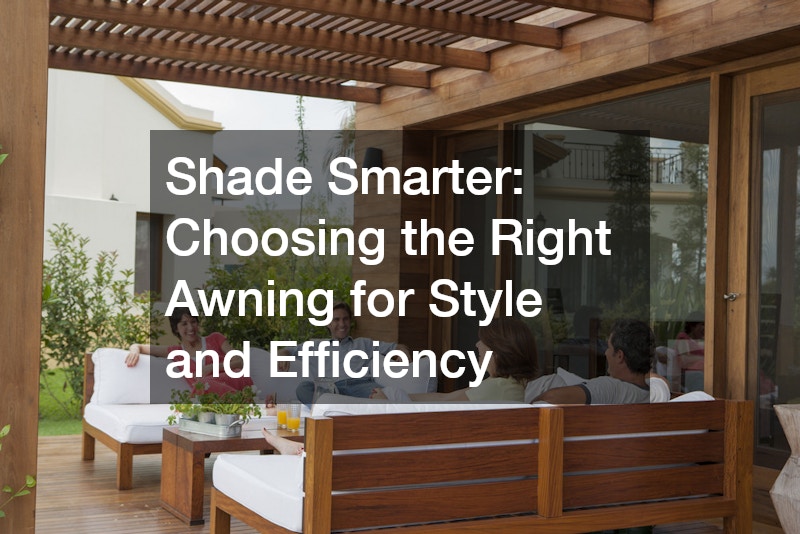Awnings are not merely functional; they can also transform a space’s aesthetic, creating a welcoming ambiance while serving practical purposes. With the right awning, you can enjoy your outdoor areas more, protect your interiors from UV damage, and reduce energy costs by improving insulation. There is a wide array of available options that can be tailored to both taste and necessity.
What Types Are Available?
Awnings typically fall into categories based on their function and structure. A retractable awning provides the flexibility of extension or retraction based on weather conditions and personal preference, making them ideal for multi-use outdoor spaces. Stationary awnings, on the other hand, offer a permanent shade solution, providing consistent coverage and often adding an architectural element to a building’s design.
Custom awnings are another appealing option, allowing homeowners and business owners to create a unique look tailored to their specific needs and preferences. These can be designed to fit unconventional spaces or architectural features, effectively enhancing stylistic coherence. Regardless of type, it is essential to consider the intended use and how much shade or shelter is desired at different times throughout the year. It should effectively balance between functionality, longevity, and aesthetic appeal.
When selecting an awning, practicality in terms of maintenance and operation should also be considered. For instance, manual versus motorized retraction systems present varying levels of ease and convenience. Each type of awning has distinct benefits that can contribute to the overall efficiency of your property, especially in climates prone to excess sunlight.
How Do They Affect Energy Efficiency?
Awnings function as an insulating layer that helps keep indoor spaces cooler by providing shade over windows and doors, meaning air conditioning systems do not need to work as hard. This simple addition reduces energy costs and can considerably enhance comfort levels in your home or business environment. A comprehensive understanding of how potential impacts on ambient temperature will aid in making informed decisions that align with energy efficiency goals.
The placement and orientation of awnings also play crucial roles in their effectiveness. For instance, installing them over south-facing windows offers significant protection from solar heat gain. Conversely, west-facing installations can mitigate the intensity of the late afternoon sun. Through correct positioning, homeowners can capture the maximum energy savings benefits while still effectively utilizing natural light during other parts of the day.
Energy-efficient awning designs may include specialized materials or reflective coatings that improve thermal performance. Understanding these options can empower consumers to choose awnings that align with both their budget and environmental values. As we move towards eco-friendliness and sustainable living, integrating such solutions into home improvement plans can have lasting positive impacts on energy consumption.
What Materials Should I Consider?
When selecting an awning, the material choice significantly affects longevity and performance. Common awning materials include acrylic, polyester, and vinyl, each offering varying degrees of durability, resistance to fading, and ease of maintenance. Acrylic awnings, for instance, are celebrated for their vibrant colors and ability to let in light while blocking UV rays, whereas vinyl options stand out for their water resistance and sturdiness.
Moreover, it is essential to consider how the chosen material will hold up against local environmental conditions, such as inclement weather or exposure to harsh sunlight. Some materials may degrade faster when exposed to salt air or prolonged sunlight, impacting the lifespan of the awning. By assessing local climate considerations, homeowners can better match their exterior shading to materials that will withstand elements and continue to perform effectively over time.
It’s also beneficial to evaluate maintenance requirements associated with different materials. Some awnings require minimal upkeep, while others may need periodic cleaning or protective treatments. Understanding these factors ahead of purchase can help homeowners make informed choices that suit their lifestyle and maintenance preferences. In essence, material selection is crucial not only for aesthetics but also for the long-term value and efficiency of the awning.
By considering the types, styles, and materials available, homeowners can make informed decisions that elevate their outdoor spaces while maximizing benefits. Awnings can serve as effective barriers against the elements while providing comfort and enhancing property aesthetics. The decision-making process encompasses not just aesthetic considerations, but practical ones as well that affect energy efficiency and material durability. In summary, a strategic choice of awning can create a flexible space that is both attractive and energy-efficient, ensuring your investment pays dividends in both enjoyment and savings.

